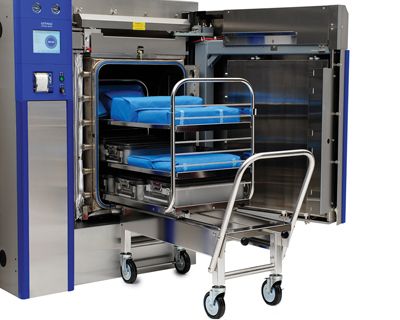Steam sterilization is one of the widely used and dependable methods of sterilization.
It is fast, inexpensive, and applicable to a wide range of products.
Sterilization is a process of removal of all the viable forms of organisms from a substance.
This is mostly meant to eradicate any living microorganisms in drug formulations, food materials, cosmetics, etc.
The presence of the microorganisms would act as contamination and possibly infect the person when those products are used.
If not, microbes would also enhance the rate of degradation of the product.
So to prevent infections and also for the long life of the product, sterilization is essential.
Steam sterilization
Steam sterilization is a type of moist heat method of sterilization done by using an instrument, namely the autoclave.
It is a very powerful method of sterilization as it can destroy microbes of all sorts from every nook and corner of the package.
Principle of steam sterilization

As the name indicates, saturated steam is used as a sterilizing agent.
It is formed due to boiling of the water at a temperature of 100 degrees centigrade.
The steam is in vapor form and is entrapped inside the autoclave without a chance of escape.
Further, pressure is applied to help in the formation of steam at lower temperatures and also enhance penetration power.
When the steam gets in touch with the material, it kills the organism by transferring the heat to the microbe.
When the heat touches the microbe, the proteins and enzymes in the cells get coagulated and denatured instantly. So the cell structure of the organisms gets destroyed, leading to immediate death.
Also, when the steam transfers the heat, it cools down and condenses to water. This creates a vacuum over the point of contact leading to further steam condensation at that point and more heat transfer.
Thus the rapid heat concentration on the microbes leads to their death without any possibility of escape.
The autoclave is maintained at said temperature for a suitable period of time. If the temperature increases, the time decreases, and vice-versa.
| Temperature (°C) | Pressure (psi) | Holding time (minutes) |
|---|---|---|
| 11-118 | 10-12.5 | 30 |
| 121-124 | 15-18 | 15 |
| 126-129 | 20-24 | 10 |
| 134-138 | 30-40 | 03 |
Lethality calculation for steam sterilization
It is calculated as inactivation factor =10 t/D (t= time and D= temperature and conditions)
Biological indicators
The process of steam sterilization authenticity relies on the use of sterilization validation.
For this, different methods are employed like the
- Browns tube
- Autoclave tapes
- Thermocouple.
- Bacillus stearothermophilus probes.
A strip of spores of Geobacillus thermophilus is used to check the validation of sterilization.
Factors regulating the process include
1. Saturated steam: The steam should be dry (>97%)
2. Pressure: This helps to attain the desired temperature faster.
3. Temperature: This provides the lethal potential to kill the microbes.
4. Time: The contact time decides the extent of sterilization. But it also varies as per other factors like temperature and pressure.
Pros of steam sterilization
- It is applicable to a wide range of substances like cotton, surgical equipment, nutrient media, water, liquid formulation, etc.
- The time of sterilization is faster compared to the filtration method and also the hot air oven method.
- Besides bacteria, even their spores (dormant forms) and toxins are destroyed.
- The technique is less expensive as it relies on water and electricity for the process.
- Large-scale sterilization can be done at a time.
- The technique is simple and easy to handle.
Cons of the method
1. Heat-sensitive materials cannot be sterilized by this method as they get destroyed when exposed to heat.
2. Powders cannot be sterilized as water can damage the product.
3. Chances of explosion due to high pressure if not handled by a technician.
Frequently asked questions and answers.
What are the four parameters required for steam sterilization?
Temperature, pressure, time and vacum are the 4 factors that affect steam sterilization.